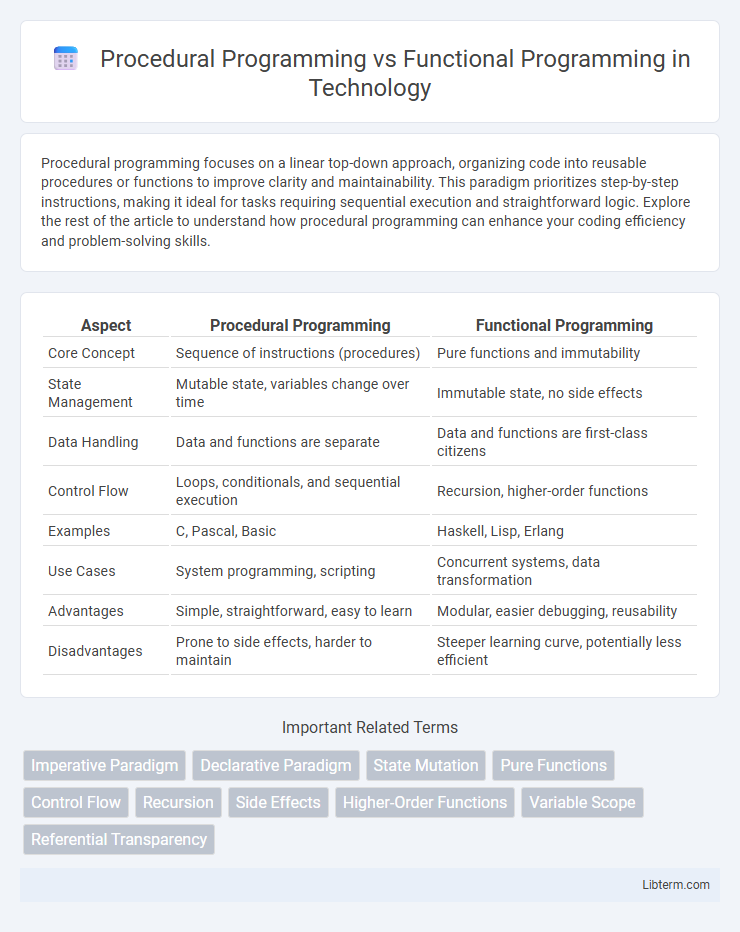Procedural programming focuses on a linear top-down approach, organizing code into reusable procedures or functions to improve clarity and maintainability. This paradigm prioritizes step-by-step instructions, making it ideal for tasks requiring sequential execution and straightforward logic. Explore the rest of the article to understand how procedural programming can enhance your coding efficiency and problem-solving skills.
Table of Comparison
| Aspect | Procedural Programming | Functional Programming |
|---|---|---|
| Core Concept | Sequence of instructions (procedures) | Pure functions and immutability |
| State Management | Mutable state, variables change over time | Immutable state, no side effects |
| Data Handling | Data and functions are separate | Data and functions are first-class citizens |
| Control Flow | Loops, conditionals, and sequential execution | Recursion, higher-order functions |
| Examples | C, Pascal, Basic | Haskell, Lisp, Erlang |
| Use Cases | System programming, scripting | Concurrent systems, data transformation |
| Advantages | Simple, straightforward, easy to learn | Modular, easier debugging, reusability |
| Disadvantages | Prone to side effects, harder to maintain | Steeper learning curve, potentially less efficient |
Introduction to Programming Paradigms
Procedural programming emphasizes a sequence of well-structured steps and routines, focusing on how a program operates through statements and control flow. Functional programming centers on the evaluation of mathematical functions and avoids changing state or mutable data, enhancing modularity and predictability. Understanding these paradigms is essential for selecting appropriate strategies in software development, impacting code maintainability and performance.
What is Procedural Programming?
Procedural programming is a programming paradigm centered on the concept of procedure calls, where code is organized into reusable blocks or functions that execute sequentially to perform tasks. It emphasizes a step-by-step approach to problem-solving by manipulating variables, control structures like loops and conditionals, and modularizing code for clarity and reuse. Languages such as C, Pascal, and Fortran exemplify procedural programming through their structured syntax and flow control mechanisms.
What is Functional Programming?
Functional programming is a paradigm centered on pure functions, immutability, and avoiding side effects to promote code predictability and easier debugging. It emphasizes first-class and higher-order functions, enabling functions to be passed as arguments or returned as values, which enhances modularity and reusability. Key languages supporting functional programming include Haskell, Lisp, and Erlang, widely used in concurrent and parallel processing environments.
Key Principles of Procedural Programming
Procedural programming emphasizes a linear top-down approach, organizing code into procedures or routines that perform specific tasks, promoting modularity and reusability. Key principles include the use of mutable state, sequential execution, explicit control flow through loops and conditionals, and a focus on step-by-step instructions to manipulate data. This paradigm contrasts with functional programming, which avoids side effects and mutable state, favoring immutability and pure functions for predictable and declarative code behavior.
Key Principles of Functional Programming
Functional programming emphasizes immutability, pure functions, and first-class functions, which help create predictable and maintainable code by avoiding side effects. It relies on declarative code that focuses on what to solve rather than how to solve it, contrasting with the stateful and sequential nature of procedural programming. Key principles include function composition, higher-order functions, and recursion, enabling concise and expressive problem-solving approaches.
Syntax Differences Between Procedural and Functional Approaches
Procedural programming relies on a sequence of statements and explicit control flow with loops and conditionals, emphasizing mutable state and step-by-step instructions. Functional programming emphasizes expressions, immutability, and function composition, using recursion instead of loops and avoiding side effects. Syntax in procedural languages often includes variable assignments and statements, while functional languages feature function calls, higher-order functions, and declarative constructs.
Advantages of Procedural Programming
Procedural programming offers straightforward control flow and easier debugging due to its linear and structured approach, making it ideal for tasks requiring clear step-by-step instructions. It efficiently manages state and mutable data, which simplifies complex algorithms involving loops and conditionals. This paradigm is widely supported by many programming languages, ensuring extensive resources, community expertise, and robust performance in system-level and scientific computing.
Benefits of Functional Programming
Functional programming enhances code maintainability through immutable data and pure functions, reducing side effects and making debugging simpler. This paradigm enables easier parallel processing due to statelessness, improving performance in multi-core environments. Furthermore, functional programming promotes modularity and reusability, which accelerates development and reduces errors.
Use Cases: When to Choose Procedural vs Functional
Procedural programming excels in scenarios requiring step-by-step task execution and state management, such as system programming, embedded systems, and simple application development. Functional programming is preferred for data transformation, concurrent processing, and applications demanding immutability and side-effect-free functions, like big data analysis, real-time event processing, and complex algorithms. Choosing between them depends on project requirements, with procedural suited for straightforward, state-dependent tasks, and functional for scalable, maintainable, and parallelizable codebases.
Summary: Comparing Procedural and Functional Programming
Procedural programming organizes code into procedures or routines focused on sequential steps and state changes, promoting clear, step-by-step task execution. Functional programming treats computation as the evaluation of mathematical functions, emphasizing immutability, first-class functions, and avoiding side effects to enhance modularity and predictability. Key distinctions include state management, with procedural relying on mutable state and functional on immutable data, and control flow, where procedural uses statements and loops contrasted with functional recursion and higher-order functions.
Procedural Programming Infographic

 libterm.com
libterm.com